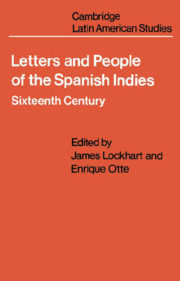Part II - The Variety of Life in the Indies
Published online by Cambridge University Press: 06 August 2018
Summary
There are many farmers and craftsmen here, and many others who make a living by their work and sweat.
Fray Toribio de Motolinia, Mexico, 1555.
Here is the core of our interest. Conquest, as conquest, was an episode. True, it divided the history of the Western hemisphere into two sharply distinguished periods, but only because of its aspect as occupation, reorganization, foundation; there it stretched forward without break into the following decades and centuries. Even before the fighting was over, the Spaniards began to fill in the framework, bare but durable, that the conquest created - the system of Spanish cities, estates to tie them to the Indian countryside, and export of precious metals as their economic leverage with Europe. Immigrants poured into the richer areas (nearly all the letters of this section relate to Mexico and Peru). Even in the first moments there had not been an encomienda for literally every Spaniard, and before long encomenderos were a small minority of a Spanish population devoted to every pursuit known in early modern Europe.
Once a frame of reference is set, these people can speak for themselves. Through their own communications they emphasize the extent and earliness of development, the endless variety of occupations and types. And they express even more directly the humanity, universality and ready intelligibility of themselves and of the whole process. There is hardly a word they say that would not fit equally well in the mouths of immigrants - and non-immigrants - much nearer to our time and place. Even the humblest Spaniards wrote letters, or found someone who could. The numerous black slaves and servants who lived beside them did not have the opportunity; at least we have found no letters from them, though they are often mentioned in the letters of the Spaniards. As to the millions of Indians among whom the whole Spanish population was a minority, and on whom it was having an enormous destructive-creative effect, a certain number of them were already producing correspondence in the European fashion, of which we include three examples.
- Type
- Chapter
- Information
- Letters and People of the Spanish IndiesSixteenth Century, pp. 63 - 64Publisher: Cambridge University PressPrint publication year: 1976



